В.Шавров История конструкций самолетов в СССР до 1938 г.
"Вуазен" 1909 г. - один из первых самолетов в Западной Европе, летавший еще в 1908 г. В Россию он попал летом 1909 г. По схеме это был трехстоечный биплан с передним рулем высоты, бипланным хвостовым оперением и толкающей силовой установкой с довольно несовершенным воздушным винтом. Характерны вертикальные переборки по концам коробки крыльев и гондола перед крылом, напоминающая по форме утиный нос. Элеронов и гоширования еще не было. На таком самолете были совершены первые в России в XX веке полеты русских авиаторов в Одессе (начиная с 12 июля 1909 г.) и французского авиатора Леганье осенью 1909 г. в Гатчине и в Москве. Летал самолет плохо, не всегда удавался даже взлет. С 1910 г. он уже не применялся.
Самолет|| 1909г.
Год выпуска||1909
Назначение самолета||Опытный
Число мест||1
Двигатель, марка||
Мощность, л.с.||40
Длина самолета, м||7,9
Размах крыла, м||10
Площадь крыла, м2||40
Масса пустого, кг||~400
Масса полной нагрузки, кг||100
Полетная масса, кг||~500
Удельная нагрузка на крыло, кг/м2||12,5
Удельная нагрузка на мощность, кг/лс||13
Весовая отдача,%||20
Скорость максимальная у земли, км/ч||~60
Скорость посадочная, км/ч||~50
Потолок практический, м||100
L.Opdyke French Aeroplanes Before the Great War (Schiffer)
Deleted by request of (c)Schiffer Publishing
Voisin
In late 1906 the Voisin brothers hired a draftsman, Maurice Colliex, and formed a new firm, Les Freres Voisin, thus becoming the first manufacturers of aeroplanes - the first real aircraft factory. They had 2 plans: first to build the often bizarre and complicated and generally unsuccessful projects of rich amateurs who wished to make something original, and thus to collect enough capital to carry out their second plan: to develop their own early designs tested on the Seine into a successful flying machine. To attract customers to both plans, Voisin decided to name the machine after the purchaser rather than himself; the firm's name appeared in small print under the buyer's. In January 1906 they designed a remarkable streamlined twin-propeller hydroplane (but Voisin's own drawing is titled Aeroplane...) for a M Filiasi.
Their first customer, Florencie, had an ornithopter designed and built; then he ordered the nacelles for first one and then another unsuccessful machine - these are all described under his name. Their second customer for whom they designed an aeroplane was Henri Kapferer, whose little Buchet-powered biplane appears under his name.
Then came the sculptor Leon Delagrange, who is better known today for having been one of the first customers of Charles and Gabriel Voisin than for his fine flying and contemporary fame as a pilot. Though he never took part in the design of any of the aeroplanes he bought - Voisins and later a Bleriot XI - he usually eventually modified them.
Delagrange (No 1): Henri Kapferer recommended the firm to his friend Delagrange who in December 1906 ordered his own machine designed and built by the Voisins; 3/4 of the purchase price would be paid only upon proof of a successful flight. Voisin attempted the first flight on 20 February 1907; it lifted briefly, but the fuselage failed. He tried again on 16 March at Bagatelle, but the torque of the motor drove it into the ground on its left wing. Adjusted, as Penaud had done to his design of 1872, with 2 kg of dead weight added to the right wing, the machine flew successfully for 60 m on 30 March.
With the announcement of the Archdeacon Deutsch de la Meurthe prize, the Voisins wanted to buy the aeroplane back, but Delagrange wanted to enter it himself; and Voisin recommended testing it with floats. Taking off the wheels, Voisin assisted with the tests of and alterations to the seaplane glider in 1907 on Lake Enghien, near Paris, and then again with wheels, finally wrecking it irreparably in a crash. The aircraft showed what was to become typical Voisin design: big biplane cells for the wings and tail, big side-curtains as vertical tail surfaces and later between the wing struts, forward elevator, big rectangular open-box structure for the tail outriggers supported at the end by 2 tailwheels, and a castering 2-wheel undercarriage.
(Span: 11 m; length: 11 m; wing area: 60 sqm; dry weight: 450 kg; 50 hp Antoinette)
The following year he replaced the Antoinette motor in one of his Voisins with a 50 hp Chenu. In the same year he bought a Channel-type Bleriot XI with a 3-cylinder Anzani and substituted a 50 hp Gnome, renaming his machine Monoplan Eclair (lightning). With a strengthened undercarriage it was the first 50 hp XI, and also the fastest: on 30 December 1909 he achieved an average speed of 78.3 kmh with a top speed recorded of 86 kmh. A few days later, on 4 January 1910, he died when his Bleriot crashed in a turn.
In March 1907 the firm also built the nacelle, propeller, and control surfaces for the dirigible Ville de Paris. They continued to build and test Chanute-type gliders mostly for the Aero Club de France in May. Then they built in 5 weeks a little 50 hp Antoinette-powered biplane with a movable nacelle for the German Hans Reissner, who went on to work with Hugo Junkers on all-metal aircraft structures. The firm also built an unsuccessful large 100 hp helicopter for the Russian, Prince Chelmiky.
Henry Farman (HF 1): Ordered on 1 June as being "the same as Delagrange's one," on the basis of payment after a one-kilometer flight, and finished at the Voisin works in August 1907, the first Henry Farman was a big boxkite arrangement covered in silk with a big biplane tail cell with a central flap for a rudder; there were no side-curtains in the wing cell. The long pointed fuselage nacelle was uncovered, with a small biplane forward elevator pivoted at the front. The wheels castered, as on the Bleriot. It hopped on 30 September 1907, but managed a 30-meter flight on 7 October.
(Span: 10.8 m; length: 13.45 m; wing area: 42 sqm: empty weight: 320 kg; loaded weight: 550 kg; speed: 60 kmh; 50 hp Antoinette)
It was modified over time: a monoplane forward elevator replaced the biplane cell; the nacelle was covered; the rudder was moved aft inside the tail cell. Then the tail side-curtains were reduced and the rudder brought forward again. Then the tail cell was shortened; a gas tank was set on the top wing and a water tank above the engine. On 13 January 1908 it made a world record flight, one kilometer, closed-circuit. It then returned to the factory and reappeared as the Ibis.
HF Ibis: The machine was restored and now covered with Continental cloth, and re-engined with a 50 hp Renault until May 1908, when the Antoinette was restored. In Belgium it received side-curtains on either side of the nacelle; in this form it flew from Chalons to Reims on 30 October, 27 km in 20 minutes. Farman's first design contribution was to modify the Ibis to triplane configuration (described under Farman).
HF II (Voisin): Henry Farman ordered this machine with a 2-meter gap instead of 1.5, but did not accept it. It may have been used as an "appareil d'essais," for testing engines.
Delagrange No 2: Seeing the success of the Farman machine, Delagrange ordered an exact copy of it from the Voisins in the fall of 1907 and flew it successfully in January 1908.
(Span: 10.2 m; length: 10.5 m; 50 hp Antoinette)
Delagrange No 3: Delagrange added side-curtains to his No 2 in September 1908, one on each side close to the fuselage, and renamed it No 3, with an Antoinette engine.
Moore-Brabazon No III: Built for the Englishman in November 1908 with a 60 hp Vivinus engine. (See below, under Standard Voisin)
Zipfel: Armand Zipfel had earlier built a glider to Voisin's instructions; he later ordered an aeroplane from the Voisin firm, patterned almost exactly on the Delagrange No III. It was built at the Ateliers d'Aviation du Sud-Estde Villeurbane, near Lyons, and Zipfel flew it first in November 1908. Later he took it to Germany, making the first significant powered flights in that country. He went on to build Voisins under license. (See also Zipfel.)
Standard Voisin: The firm put their best model into production, the first one being completed in December 1908. The ribs in both wings and tail were identical; 19 types of aluminum castings were used, and a variety of sheet-steel engine mounts allowed variation in selection of powerplants. The first aircraft was sold to JTC Moore-Brabazon, who called it Voisin No III, since he had attempted to fly in 2 earlier aeroplanes, one of which may have been Goupy's abandoned triplane. Initially fitted with a 50 hp Vivinus automobile engine, it was later re-fitted with a 50 hp Antoinette with the nacelle covered. Moore-Brabazon then ordered a second Voisin, this one called No IV, fitted with an ENV and wider gap. 60 or so were built, exhibited, sold, and raced, in the course of 1908 and early 1909.
(Span: 10 m; length: 10.5 m; wing area: 49.75 sqm; empty weight: 445 kg; 50 hp Antoinette)
Among the purchasers were the Aeroclub of Odessa; de Baeder; Bregi (this machine was offered by L'Aviation); Bunau-Varilla; de Caters; Dufour; Ferber; Fournier (No 1); Gaudart (Daumont I); Gobron; Hansen; Jacquelin, Kluytmans, Koch; Legagneux; Lesire; Ligue Nationale Aerienne (2 a/c called Alsace and He de France); Metrot; Morveaux; Paulhan (who won it in a contest - see Paulhan); Poillot; Richer; Rigal; de la Roche; Rougier (No 1); de Salvert; Sanchez-Besa; des Vallieres; Vivinus. Similar Voisins were license-built in Italy for Anzani, Cagno, and Florio.
Farman, Henry
It is curious that among the most famous of the French pioneer aviators, Henry Farman and his brother Maurice, were the children of English parents; they grew up in Paris speaking little English, and Henry (who later sometimes spelled his name Henri), became a French citizen. His grave is in the cemetery of Passy, in Paris, and his stone is inscribed Henry Farman.
Both Henry and Maurice soon became interested in bicycling and both became skilled bicycle-racers. Henry and a third brother, Dick, opened an automobile dealership in Paris, but Henry was badly hurt in an car accident and shifted his attention to other things. He watched Voisin fly his gliders, and on 1 June 1907 ordered his first aeroplane from the Voisin firm after seeing the Voisin-built Delagrange No 1 in flight in March 1907.
HF I: His aeroplane was designed and built by the Voisins, and is described under their name.
HF Ibis: Voisin's modifications to the HF 1 are described under Voisin. But in November Farman himself modified it further: this was Henry Farman's first real design contribution. He rebuilt it as a triplane with the addition of a short high-set wing, 4 ailerons, the outer pairs of side-curtains with cut-outs to allow movement of the ailerons. It reverted to biplane configuration on 28 November with an enlarged tail cell; and then in December back to triplane, when it was sold to an Austrian syndicate where it was rebuilt once again as a biplane and Legagneux crashed it.
Kapferer
Graduate of the Ecole des Mines, collaborator and nephew of Henri Deutsch de la Meurthe, Henri Kapferer was well known as a balloonist; but it was he who in 1904 suggested to his uncle that he should sponsor research into heavier-than-air machines, and his suggestion was followed by the creation of the Prix du Kilometre, which was won by Henry Farman on 13 January 1908. Through the support of men like de la Meurthe and the banker Lazare Weiller, the powers of money stood guarantee for the new industry.
Henri Kapferer is not included in this section as a constructor but as a buyer and enthusiast: he had 4 aircraft built, but none of them were of his design. With Leon Delagrange, the first client of the Voisin brothers' aircraft manufacturing firm, he ordered a Voisin biplane late in 1906. Though warned to use a light motor of at least 40 hp, he fitted to his new machine a heavy and useless 20/25 hp V8 Buchet. Tested unsuccessfully on the Sartrouville grounds on 1 March 1907, the machine was abandoned.
A.Andrews. The Flying Machine: Its Evolution through the Ages (Putnam)
At Billancourt, a mile away from Issy on the other side of the Seine, the brothers Charles and Gabriel Voisin had set up the world’s first aircraft factory, where they developed their own rather pedes¬trian designs, but, much more importantly, coped with all comers by fulfilling individual orders. Among their clients were the friendly rivals Henry Farman and Leon Delagrange.
Henry Farman, whose father had settled in Paris as a newspaper correspondent, was of British nationality, though he could speak no English. He did not take French nationality until 1937, and he survived until 1958, when he was 84. He was trained as an art student — an extraordinary number of early pilots and aircraft designers were artists — but he abandoned art, first for cycle racing and then for automobile racing, winning the heavy car class of the great Paris-Vienna race of 1902 in a 70hp Panhard. In 1907, at the age of 33, he was ‘converted’ to aeronautics, and commissioned from the Voisin brothers one of the stock biplanes they were then producing. (They had filched the design from an inaccurate diagram of the Wright machine of 1903.) This had box-kite configuration of wings and tail unit, with pusher propeller and forward elevator. Farman speedily modified this, and by November 1907 he had achieved a flight of over a minute. After further modification he flew the Voisin-Farman I (mod) on the first half-kilometre-and-back {Kilometre boucle, or kilometre return-to-base) accomplished in Europe, at Issy on 13 January 1908. Leon Delagrange, flying a machine with very similar progressive modifications, the Voisin-Delagrange II and III, accomplished in the first six months of 1908 flights that gradually improved to a 14km stretch done in 18 1/2 minutes. Farman maintained a parallel progression.
Журнал Flight
Flight, January 2, 1909
THE WRIGHT AND VOISIN TYPES OF FLYING MACHINE.
A COMPARISON BY F. W. LANCHESTER.
The Voisin Machine. Origin and Description.
MM. Voisin began their experimental work some years before their name was known to the general public, or rather some years before their machines came into public prominence through the exploits of Farman and Delagrange, for comparatively few people, even at the present time, are even aware of the name of the makers of these most successful machines. In 1904, MM. Voisin constructed for M. Archdeacon some cellular kites of a large size, of very much the form of their present type of machine ; these were tested in tow of a motor launch on the Seine, and provided much of the data that MM. Voisin afterwards utilised in the construction of the actual flying machines that brought their work into public prominence.
MM. Voisin (and their engineer or works manager M. Colliex, who is largely responsible for their designs) make no secret of the fact that they have based their work on that of pioneers such as Lilienthal, Langley, and others, and in fact they say that they never miss an opportunity of utilising any information or data on which they can lay hands. On the other hand, much of their work is based on their own researches; they appear to take little for granted, having equipped themselves with an "artificial wind" apparatus, with which they test their work on a small scale before finally settling a design.
The Voisin factory is on a comparatively small scale; the output and work in hand at date includes (amongst others) some five machines of the Farman-Delagrange type, and four machines of a modified pattern, with an aerofoil consisting of three superposed members. The former is the only type of machine for which flight data are to hand, and in the remarks that follow it is this type to which reference is made as the Voisin machine.
It appears from statements made to the author by MM. Voisin (and confirmed by Mr. Farman himself) that when their designs were prepared, the first order they obtained was from M. Delagrange and the second from Mr. Farman, who placed his order for what was practically a duplicate machine. That Farman made successful flights before Delagrange was due in the main to the fact that he had made in advance appropriate arrangements for testing and trials on the Champ de Manceavres at Issy-les-Moulineaux, a precaution that the latter neglected, and it would seem that it is hopeless to attempt to fly, at least with a new machine, without some such provision. It also appears that the Delagrange machine went through some kind of a history in its early state, the wheels fitted in the first instance not being arranged as it was subsequently found necessary to arrange them, namely, as castors, or as the French express it, " orientable." It is this provision that takes care of any slight side component of the wind when starting and alighting which might otherwise upset the machine.
The Voisin machine is given as weighing complete, with Mr. Farman " up, " 1,540 lbs. (700 kilogs.), and has a total supporting surface of 535 sq. ft., this being the combined area of the horizontal members of the aerofoil and the tail, both being used for sustentation, though there are reasons for supposing that the pressure per sq. ft. on the aerofoil is greater than on that of the tail.
The ordinary maximum velocity of flight is approximately 45 miles per hour, or 66 ft. per sec. ('=72 kiloms. per hour).
In addition to the horizontal sustaining members of the aerofoil and tail there are a number of venical members whose function is to preserve and control the direction of flight, and to give lateral stability; these have a total area of approximately 255 sq. ft.
The supporting surfaces of both aerofoil and tail are of rectangular plan form, the former being 10 metres by 2 metres, and, therefore, having an aspect ratio - 5. The aspect ratio of the tail members is 1 '25; they are, therefore, nearly square.
The Voisin machine is propelled by a single screw of 7 ft. 6 in. diameter (2-3 metres), of which the effective pitch is approximately 3 ft. (the actual pitch is much greater, the "slip" being excessive). The propeller is keyed direct to the motor shaft.
The motor fitted to the Voisin (Farman) machine is an 8-cyl. "Antoinette," 4-35 ins. diameter by 4-15 ins. stroke ( 110 mm. by 105 mm.), stated to give 49 b.h.p. at 1,100 revs, per min. ; its weight is given as 265 lbs. (120 kilos.).
It is said that the gliding angle of the Voisin machine was at first approximately 1 : 5 or 11 degrees, but that by detail improvements in diminishing framework resistance by rounding off and covering in to form stream-line sections, the gliding angle has been improved, and is now about '16 radian, that is between 1 : 6 and 1 : 7, or 9 degs. approximately.
Flight, January 9, 1909
THE FIRST PARIS AERONAUTICAL SALON.
"Delagrange No. 3."
Biplane constructed by Voisin Freres, and exhibited by the Soc. d'Encouragement d'Aviation in order to advertise their new Juvisy Aerodrome, which opens on January 10th. The general lines of the machine are well known to readers of The Automotor Journal. It has in addition to the two main planes an elevator in front and a rudder enclosed by a box-kite tail behind. The pilot sits in the centre between the main planes, and is thus just in front of the engine # a 50-h.p. 8-cyl. Antoinette # which drives a 2-bladed propeller mounted on the end of its crank-shaft. There are two side curtains between the main planes, one near each end.
"Voisin-Farman No. 1"
Biplane constructed by Voisin Freres on the lines of "Farman No. 1," and equipped with a dummy pilot to give reality to its setting over the grand staircase, where it looks for all the world as if about to fly off from the balusters. The general lines of this machine are the same as the " Delagrange," and it presents the same workmanlike appearance which is characterising the Voisin productions. It is neither clumsily heavy nor flimsily light, but appears to have just a reasonable degree of rigidity which does the builders credit for their judgment in design.
Flight, February 20, 1909
Moore-Brabazon and His Engines.
MR. MOORE-BRABAZON is trying another engine on one of the Voisin aeroplanes, and this time it is an E.N.V. 8-cyl. motor which he has selected.
Moore-Brabazon Flies Easily.
WITH the new engine Moore-Brabazon has got along much more smoothly in his flying. On Wednesday, at Issy, in the early morning, he repeatedly made circular kilometre flights without the smallest sign of effort, his machine behaving splendidly. So much so, that he already sees himself on the way for a long flight. His biplane is to be transferred to Chalons, where a special hangar is now being erected, and he then intends to try for some more ambitious records, bringing him a little nearer to the top than the fifth place at present reached by him.
Flight, March 27, 1909
FLYERS AT OLYMPIA.
"The Bird of Passage" (J. T. C. MOORE-BRABAZON).
Such is the name which Mr. J. T. C. Moore Brabazon has given to his No. 4 flyer which, like its predecessors, was constructed by Voisin Freres in France. It is the actual machine with which Mr. Moore-Brabazon made his latest famous flights at Issy, and it is the only flyer in the Show that has actually flown incidentally, the mud on the wheels and chassis give the fact an air of practical reality. This particular flyer which is, of course, typical of the Voisin construction and to which our remarks about the Voisin machine exhibited by Mr. F. R. Simms therefore apply, happens to have been the first of the new pattern in which the distance between the main decks was increased from 1.5 metres to 2 metres. "The Bird of Passage" is equipped with an E.N.V. 8-cylinder engine which drives a twin-bladed propeller direct. The pilot sits in front of the engine in a rectangular car which projects forward to carry the elevator. Directly in front of him is a steering wheel like that on a motor car, but set on a horizontal spindle; this wheel the pilot turns to steer and pushes bodily to and fro in order to ascend and descend.
Voisin (F. R. SIMMS).
The biplane exhibited by Mr. F. R. Simms, who has secured the sole concession for these machines in this country, is one of the standard Voisin machines and affords an excellent example of the Voisin system of construction. Next to the Wrights', the Voisin flyers have been the most successful which have yet taken their place in the air. The great feature of the Voisin system is, as our readers know, the use of a box-kite tail, carried by an outrigger framework some distance behind the main plane. This tail, which encloses the rudder, is itself employed for the purpose of giving automatic longitudinal stability, the idea being that the wind blowing on to the tail uses the leverage afforded by the outrigger framework to bring the machine once more on to an even keel. In front of the main planes is an elevator, and between the main planes there are fixed four vertical side curtains; the car which carries the engine and the pilot is also covered with fabric.
The Voisin machine is certainly a well-built job, and it has a number of constructional details of considerable interest, some of which may or may not, of course, stand the test of time. The main planes are single surfaced, and the decks are thus very thin and flexible, which causes the spars and libs to stand out rather prominently; each member is, however, encased in its own special bag.
It is a feature of the Voisin design, possibly resulting from certain details of construction, that each main plane as an overhung flexible rear edge which can adjust itself to the air streams. The elevator in front, on the contrary, is rigid fore and aft, and has top and bottom surfaces, which are nearly two inches apart at the thickest point. All the struts of the Voisin machine are elliptical in section, and have sharp cutting and trailing edges; they are neatly and rigidly mounted in aluminium sockets, which are bolted to the main spars. All the tension wires are adjustable. The machine is mounted on a two-wheeled chassis in front, and has a pair of small wheels under the tail; the suspension of the former is effected by long helical springs.
Delagrange (MASS CARS).
The Delagrange biplane as exhibited by the Mass Co. is a slightly modified Voisin machine; the modification consisting in the abolition of the four vertical side curtains which the Voisin machines proper employ between the two outer pairs of struts separating the main planes. In the machine shown, too, the distance between the main planes is 0.5 metre less than that on the modern Voisin machines. The control is unaltered and the details of construction are likewise unchanged; the engine with which the flyer is equipped is a 50-h.p. 8-cyl. Antoinette.
M. Delagrange has, as readers of FLIGHT know, met with a considerable measure of success with these machines. He was one of the early winners of the Aero Club of France 200 metres prize, and for a brief period before Wright's achievements in that country, actually held the world's record with a flight lasting nearly 30 minutes, during the course of which he accomplished a distance of 247 kiloms., by making 15 1/2 circuits of the Issy Parade Ground. Among other places, he has flown in Rome, and among other notable facts in connection with his performances is that he took aloft the first lady passenger, Madame Therese Peltier.
Flight, April 3, 1909
Aeroplanes to be Blessed.
IT has been no very uncommon thing to record in the past the blessing of motor cars by the Roman Church in France. Apparently the same procedure in some quarters is to be followed in regard to flying machines, as a formal gathering this week took place on April ist at the invitation of the Compagnie d'Aviation at Juvisy, when benediction was pronounced by the Archbishop of Paris and the Bishop of Versailles over the aerodrome of the above-named company, and incidentally over the flyers which happened to be there at the time. We await with curiosity the name of the special Saint under whose protection aeroplanes have been placed.
Flight, April 10, 1909
Blessing Aerodromes and Aeroplanes.
LAST week we referred to the innovation of blessing the new aerodrome at Juvisy and the two Delagrange aeroplanes there. We now give in our frontispiece a couple of photographs illustrating this curious ceremony. It will be sean that a sort of grand stand was erected for the occasion, and to the front of this the two aeroplanes were brought. The service was commenced by Mgr. Amette, the Archbishop of Paris, delivering an address, in the course of which he said that man by his original fall lost the sovereignty of the air, but the present inventions permit it to be hoped that man may be allowed by Divine grace to regain some small fragment of his original sovereignty. The Church was therefore happy to bless the machines, destined to soar through space and conquer realms hitherto beyond man's domination.
Short prayers were then uttered that those using the aeroplanes might be preserved from accident, after which one of the aeroplanes was named "Ile de France," by Baroness Lagatinerie, and the other "Alsace," by Madame Dussand, and sprinkling them with holy water, the Archbishop blessed them. At this moment a change came over the heavens, and, as if in sympathy with the Archbishop's movements, rain fell in torrents, causing the "godmothers" and the assistants to flee for shelter. About five hundred people witnessed the ceremony, including the Duke and Duchess of Rohan, Princess Murat, Prince and Princess Leon, Marquis and Marchioness of Castellane, Marquis and Marchioness of Puybaudet, &c.
Flight, May 1, 1909.
PRESENT STATUS OF MILITARY AERONAUTICS.
By GEORGE O. SQUIER, Ph.D., Major, Signal Corps, U.S. Army.
REPRESENTATIVE AEROPLANES OF VARIOUS TYPES.
The Farman Aeroplane (Fig. 24).
The Farman flying machine has two superposed aero-surfaces 4 ft. 11 ins. apart, with a spread of 42 ft. 9 ins. and 6 ft. 7 ins. from front to rear. The total sustaining surface is about 560 sq. ft.
A box tail 6 ft. 7 ins. wide and 9 ft. 10 ins. long in rear of the main surfaces is used to balance the machine. The vertical sides of the tail are pivoted along the front edges, and serve as a vertical rudder for steering in a horizontal plane. There are two parallel, vertical partitions near the middle of the main supporting surfaces, and one vertical partition in the middle of the box tail. A horizontal rudder in front of the machine is used to elevate or depress it in flight.
The motor is an 8-cyl. Antoinette of 50-h.p. weighing 176 lbs., and developing about 31-h.p. at 1,050 r.p.m.
The propeller is a built-up steel frame covered with aluminium sheeting, 7 1/2 ft. in diameter, with a pitch of 4 ft. 7 ins. It is mounted directly on the motor-shaft immediately in rear of the middle of the main surfaces.
The framework is of wood, covered with canvas. A chassis steel tubing carries two pneumatic-tyred bicycle wheels. Two smaller wheels are placed under the tail. The total weight of the machine is 1,166 lbs. The main surfaces support a little over two pounds per square foot. The machine has shown a speed of about 28 miles per hour, and no starting apparatus is used.
On January 13th, 1908, Farman won the Grand Prix of the Aero Club of France in a flight of 1 min. 28 secs., in which he covered more than a kilometre. It is reported that on October 30th, 1908, a flight of 20 miles, from Mourmelon to Rheims, was made with this machine.
Flight, May 29, 1909.
Opening of the Juvisy Aerodrome.
THE opening of Port Aviation - the aerodrome at Juvisy - on Sunday last was somewhat in the nature of a fiasco. Great preparations had been made, and it had been extensively advertised that there would be an exciting aeroplane race between Delagrange, Rougier, Bleriot, and others. A large crowd of spectators, estimated by some people as something up to 100,000 - probably 10,000 is nearer the mark - assembled and patiently waited for some hours to see the flyers in the air. The kite-flying competition which was on the programme for the afternoon did not secure a great deal of interest, and as there was no signs of the aeroplanes being put through their paces, murmurs of discontent began to arise. At last M. Delagrange made several short flights, but that did not satisfy the crowd. Eventually, about five o'clock, it looked as though some damage would be done, as the crowd began to encroach on the course and threatened to invade the pay-offices and smash the grand-stands, &c, up. With characteristic pluck, M. Delagrange came to the rescue. Although he was hampered by the people swarming on the course, he started off and covered five circuits of the course. Rougier also made an attempt to fly, but he was so unnerved by the people crowding upon him that he was unable to complete one circuit. The judges therefore decided that M. Delagrange was the winner of the Lagatinerie Prize, but as only two machines competed, the value of it, in accordance with the rules, was reduced to 2,500 francs. The official record of M. Delagrange's flight states that he covered five circuits, a distance of 5.8 kiloms., in 10 mins. 18 3/5 secs.
The next event at Port Aviation is to be held to-morrow (Sunday), and will take the form of a high jump contest, a line of balloons being fixed at a height of 25 metres, and the competitors having to "jump" over them.
Flight, July 10, 1909
M. Paulhan Flies.
"SLOW but sure" is the motto of M. Paulhan, who has been practising on his Voisin biplane at Issy, and for some days last week he contented himself by making several "jumps" in order to familiarise himself with the handling of the machine. On Saturday, after several short flights of about 200 metres in length, he decided upon a more extended flight and made not quite five circuits of the grounds, amounting to about eight kiloms., the altitude not being very great, varying between two and five metres. He then gave notice to the Aero Club that he would make an attempt on Monday to win one of the 500-metre prizes, but unfortunately some trouble was experienced with the motor, and although the machine made several short jumps, it did not keep going sufficiently long to cover the course. M. Paulhan is, however, very well pleased with his progress, and is now at Douai, where he intends to take part in some of the competitions there.
Flight, July 24, 1909
Captain Ferber at Belfort.
ON Sunday last, Captain Ferber made several flights on the Champ de Mars, on a Voisin biplane. The secret of the identity of Captain Ferber and the successful "De Rue" is now an open one. It will be remembered we referred some weeks ago to "De Rue" being the assumed name of a well-known aeronautical enthusiast.
Captain Ferber also made six very successful flights on Tuesday of this week at Belfort, although they were all fairly short. Satisfied with the running of his machine, he thereupon had it sent off to Vichy for the meeting.
Flight, August 14, 1909.
THE VOISIN BIPLANE, 1908-9 TYPE
A DETAILED DESCRIPTION OF MR. MOORE-BRABAZON'S "BIRD OF PASSAGE," TOGETHER WITH SCALE DRAWINGS WHICH HAVE BEEN OBTAINED THROUGH THE COURTESY OF THE OWNER FROM THE ORIGINAL MACHINE.
WHILE Farman and Delagrange were arousing the enthusiasm of France, and attracting the keen interest of all nations to their brave and diligent attempts to conquer the air, the designer and constructor of the first practical type of French flyer remained in comparative obscurity; for the moment everyone overlooked the man behind the machine. M. Voisin commenced his experiences in flight at a sufficiently early period in the modern history of the movement, for he made his first public effort as pilot of the glider with which M. Bleriot inaugurated aerial experiments over the Seine. Bleriot's glider was towed by a fast motor boat, and more than once M. Voisin found himself prematurely plunged thereby beneath the surface of the water. When Voisin and his brother settled themselves down to the designing of a motor-driven machine, they made no particular outcry about the occasion. It was not until after the successful flights which Farman and Delagrange had made with their device had been adequately applauded, that France herself began to realise who it was that produced them. For his work, however, M. Voisin has received the very just award of having his name included on the first list of decorations to be awarded in connection with the science and art of flight.
One of the first of those to secure a Voisin flyer was Mr. Moore-Brabazon, and it is of this machine, now housed at Shellbeach, that the owner has very kindly permitted us to make the accompanying scale drawings for the benefit of readers of FLIGHT. Mr. Moore-Brabazon's "Bird of Passage," as he has named his flyer, is a machine with which he has achieved several flights. In fact, his early progress in the mastery of the air with it was remarkable. Since its arrival in this country he has also flown, but not to the same extent, partially owing to the inclemency of the present summer.
Leading Characteristics.
The Voisin flyer is an original type of machine, and it is therefore the more important to specifically state its leading characteristics. Broadly speaking, the great point in the Voisin flyer is the fact that it has a tail, this member consisting of a kind of open-ended box carried at the rear upon a light outrigger framework extending some thirteen feet behind the main decks.
Having two principal supporting surfaces, the Voisin flyer belongs to the biplane class, and in this respect is similar to the Wright machine, with which it has another point in common, in the presence of an elevator. The elevator consists of a pivoted plane mounted about six feet in front of the main decks. Apart from the presence of the tail, the greatest contrast between the Voisin and Wright types lies in the absence of any wing warping or other special method of maintaining lateral stability in the Voisin flyer, beyond what is available from the effects of steering by the rudder.
Unlike the Wright flyer, which is supported upon runners or "ski," the Voisin machine, when on the ground, rests upon a wheeled chassis, and it is a leading characteristic in the construction of the machine that this chassis is attached to a kind of girder which supports the engine, contains the driver's seat, and carries an extension on which the elevator is mounted. This chassis-frame is one of the elements into which the machine can be dismantled for transport.
The last, but by no means the least important, characteristic of the Voisin flyer is its use of a single high-speed propeller mounted direct on the crank-shaft of a 50-h.p. engine.
The Main Decks.
The main decks have a total span from tip to tip of approximately 33 ft., and a fore and aft chord of 6 ft. 9 ins. They are single-surfaced with fabric which is stretched over a foundation consisting of ash ribs lying across two transverse main spars. Two spars are placed about 5 ft. apart, and the ribs, which end up flush with the front spar, overlap the rear member a matter of 21 ins., whereby the trailing edge of the decks becomes flexible to a limited extent. This flexible trailing edge is a feature of Voisin construction, as also is the single-surfacing of the decks.
The "Continental" surface fabric is so attached that it lies beneath the ribs, but these members are enclosed in pockets of the same material; it is this feature of the construction which gives the uneven appearance to the upper surface of the deck. In order to avoid sharp angles, the main transverse spars are also covered by strips of fabric so fastened that they give the spars a virtual triangular section.
All the ribs which lie between the two main spars are not alike, for at intervals coinciding with the vertical struts which separate the decks the ribs are considerably larger, and are built up to form an inverted T section. Before being mounted, the ribs are permanently set to the required shape, so that the decks when surfaced shall have the proper camber.
The Tail.
The tail, which is also of biplane form, is constructed on exactly similar lines to the main decks, and although it has a smaller gap, and a much shorter span, the chord is the same dimension. The area of the two decks of the tail is nearly one-quarter of the area of the main decks, and it is necessary to bear its value in mind when considering the effective supporting area of the whole machine. The aspect ratio of the tail is only a little more than unity.
The Elevator.
Unlike the tail, the elevator does not resemble the main decks, either in its form or construction, for in the first place it is of the monoplane type, secondly it is double-surfaced. The elevator is, owing to its method of mounting, divided into two equal portions on either side of the girder frame, which juts out in front of the main deck. The area of both parts combined is 45 sq. ft. or a little more than one-tenth of the area of the main decks. Its effective span is 13 ft. 10 ins., and as its chord is 3 ft. 3 ins. the aspect ratio of each portion is about 2.
The ribs which stiffen the elevator are sufficiently thick at the maximum section to allow the hinge-rod to pass through them, and fore and aft of this point, which lies 10 1/4 ins. behind the leading edge, the ribs taper to a point. The hinge-member consists of a 1 1/4-in. steel tube, and the maximum depth of the elevator at this point is about 2 1/2 ins. Being double-surfaced, that is to say, having a fabric covering top and bottom, the ribs and the hinge are entirely enclosed. The elevator is virtually cambered by its arched upper surface; the bottom surface is approximately flat.
The operation of the elevator is carried out by means of a connecting-rod attached to the steering-wheel spindle. This latter member is mounted so that it can slide in its bearings, and the pilot is thus able to set the elevator by pushing and pulling the steering-wheel bodily to and fro.
The Rudder.
The rudder resembles the elevator in form and construction. It is situated between the decks and the tail, being mounted upon a vertical hinge pivoted upon the rear transverse spars of the tail decks. Owing to the tail itself having a flexible trailing edge most of the rudder lies wholly within the tail, only about 1 ft. 3 ins. of its chord projecting in the normal position. The hinge of the rudder is about 18 ft. 4. ins. behind the rear edges of the main decks.
The operation of the rudder is effected by wires, which pass round a wooden drum on the steering spindle.
(To be concluded.)
Flight, August 21, 1909.
THE VOISIN BIPLANE, 1908-9 TYPE.
A DETAILED DESCRIPTION OF MR. MOORE-BRABAZON'S "BIRD OF PASSAGE."
(Concluded from page 488.)
Side-Curtains.
ANOTHER feature which characterises the Voisin flyer is the presence of side-curtains between the main decks and also between the decks of the tail, these members being thereby converted into a kind of box-kite construction. Between the main decks there are four sidecurtains, one at each end and another between the vertical struts adjacent to those at each end. They consist of sheets of the same surface material as is employed for the decks, and are stiffened by fiat ribs enclosed in pockets. To a certain extent they may also receive support from the diagonal wireties which lie adjacent to them.
The real utility of sidecurtains has been questioned by some aviators, and M. Delagrange has flown a Voisin machine without them. Leaving aside all considerations affecting those employed between the main decks, it appears to us that the possible influence on the effectiveness of the rudder, of those in the tail, ought certainly to be taken into consideration. We have already pointed out that the rudder is almost entirely enclosed within the tail, and it is difficult to believe that the side curtains do not effect its action.
The part played by the side-curtains between the main decks is not altogether too well defined. They afford a considerable extent of cutwater, which doubtless assists the machine in turning, and it is possible that they also tend to minimise the direct effect of side gusts suddenly striking the machine obliquely.
Engine and Propeller.
After trying various different engines, Mr. Moore-Brabazon finally selected an E.N.V. motor of 50-h.p. It is an engine of the 8-cyl. "V" type, and of very substantial construction, although specially designed for flight.
The propeller is mounted direct on an extension of the crank-shaft, and is a two-bladed construction in steel. The blades are riveted to detachable arms, which are bolted to a separate boss in a manner which is clearly illustrated in an accompanying sketch. Some observations on the pitch and efficiency of the Voisin propulsion will be found in FLIGHT, vol. 1, p 16. In front of the engine, and immediately behind the pilot's seat, is a large honeycomb radiator.
The engine is mounted on a light girder framework of steel, an arrangement which is well illustrated in the accompanying photographs.
Control.
The control of the Voisin flyer is carried out entirely by the aid of the elevator and the rudder, the former being operated by pushing and pulling the steering wheel bodily to and fro, and the latter by turning the wheel upon its axis. The steering follows the same direction as on a motor car; pulling the steering wheel tilts the front edge of the elevator for temporary ascents. The purpose of the elevator is to produce temporary ascents or jumps by altering the angle of incidence of the main planes to the relative wind, and also to check any longitudinal oscillations which may occur, The elevator, although a means of beginning an ascent, is not itself endowed with any capacity for causing ascent to be maintained, that alone can result from an increase in the engine power beyond what is necessary to sustain horizontal flight. Lateral stability is maintained by suitably steering the machine, so as to give the depressed wing tip such an increased relative velocity to the air as will cause it to have a greater lift.
The Chassis.
The weight of the machine, with the exception of that part represented by the tail, which is independently supported by a pair of small wheels, rests upon two bicycle wheels shod with 650 by 65 mm. tyres. These wheels are mounted upon a tubular framework, and have a. track of 4 ft. 8 1/2 ins. They are so arranged that they can swing, together, to one side or the other of their normal position, like the castors of a chair, a feature which is essential in order to preserve the equilibrium of the machine when it runs along the ground. In order to restrain these movements on the part of the wheels, their hubs, which are joined by a hinged axle, are anchored to the chassis frame by tension springs, which always tend to draw the wheels back again to their normal positions.
Suspension.
The suspension of the flyer upon the chassis is effected by a pair of long helical springs. Each spring is mounted about a steel column which extends upwards from the chassis and passes through a bracket attached to the girder frame which carries the engine. This bracket serves as an abutment to the upper end of the spring, and it also carries a rubber pad to cushion the effect of the recoil. This point forms one of the attachments of the chassis to the frame, the other attachment being formed by a radius-rod which is hinged directly to the frame at a point further in front. When the springs compress, the effect of these radius-rods is to cant the uprights about which the springs are mounted, a point which should be borne in mind when considering the stresses to which the supporting brackets are liable to be subjected.
Pilot's Seat.
The pilot's seat in the Voisin flyer is situated about a third of the chord behind the leading edge of the main plane, and is contained within the girder frame which carries the engine and the elevator. On Mr. Moore-Brabazon's machine the seat consists of a simple board, hinged so that it can be raised for access to the starting handle of the engine, which lies almost immediately beneath it. The relative position of the seat to the other principal members is clearly shown by an accompanying sketch.
Girder Work.
From a constructional point of view a flyer presents a series of special problems in girder work, and it is therefore always instructive to consider the design on this basis. The main planes of the Voisin machine constitute together a kind of lattice girder, in which vertical wood struts alternate with diagonal piano-wire ties. Here and there extra struts and tie-wires have been introduced in the manner illustrated by an accompanying diagram which shows the staying of the main spars forming the leading edges of the decks.
A point which is always of considerable importance to observe in this connection, is the continuity or otherwise of of the girder from end to end, and special attention should therefore be paid to the manner in which the lower spars of the main decks are carried across through the supplementary frame used for the engine. In the Voisin construction the front spar is divided at this point and fastened to the engine girder by a bracket, an intermediate member belonging to the girder bridging the gap.
Another example of girder work in the Voisin flyer is the outrigger carrying the tail, but this consists of four rectangular spars attached by brackets to the rear transverse spars of the main decks. Each pair of spars in a vertical plane constitutes a lattice girder, and is braced in a similar manner to the spars in the main decks. There as no bracing, however, between the spars in a horizontal plane, other than that afforded at each end by the tail and the main decks respectively.
The girder, to which the chassis is attached, which carries the engine, the pilot's seat, and the elevator, is a semi-elliptic construction formed by four longitudinal spars braced together by wood struts and diagonal wireties. In the vicinity of the engine tubular steel struts are used instead of ash, and the blank end of the girder is finished off with a pressed steel member, which braces three sides simultaneously.
Constructive Detail.
Considerable attention has already been given to the joints and fastenings of the Voisin flyer in other issues of FLIGHT, so that our readers are already familiar with the aluminium socket-brackets by means of which the struts of the machine are fastened to the spars. This in itself is a feature of the Voisin construction not alone as a detail but also because of the rigid system which it represents. The joints in the Voisin flyer are designed to be quite rigid throughout, and the tie-wires have tighteners fitted to them, so that they can always be kept taut. On the contrary, the Wright flyer has hook-and-eye joints between the struts and the spars, and the tie-wires are not specially stretched in place; the whole machine is, in fact, built so as to be slack, and therefore able to give when strained.
Materials.
Ash is used throughout in the construction of the machine, with the exception of the steel tube work employed in the chassis. As timber, ash is characterised by its flexibility, and on the Voisin machine it must be confessed that there is not lacking evidence of its capacity in this respect, many of the struts and spars being very much inclined to bend under the load imposed upon them. In flying machine design every effort is, of course, made to keep down the weight, and sections have to be reduced to a minimum in consequence.
For the small fittings such as the socket-brackets for the struts, aluminium is employed, and this metal was also used for the main supporting brackets above the springs, until it gave way during a rough landing. Messrs. Short Brothers then introduced a pair of manganese steel brackets when making the repair, and as these members are in any case not large, the increase in weight is in no way comparable with the value of the additional strength thus obtained for such an important member
The fabric used for covering the decks is Continental rubber-proofed material.
Dimensions.
Most of the important dimensions likely to be of primary interest to the reader are given on the full-page plan and elevation. There are a few others, however, which it may be of interest to summarise here. The spacing of the ribs in the main decks is approximately 1 ft. 3 ins.; their camber is given by an accompanying diagram. The main transverse spars in the decks are 1 1/2 ins. fore and aft and 3/4 in. deep, but the section is not symmetrical, being cut away to sharpen the leading edge. The ordinary ribs have a section of about 5/16 in. by 3/4 in., while the main ribs of the section are 1 1/2 ins. wide at the base. The struts have a maximum width of 1 1/2 ins. and a maximum depth of 2 ins. They taper slightly towards the extremities, and have a sharp-pointed elliptic section. The longitudinal spars forming the outrigger which carries the tail have a mean section of 1 1/2 x 1 x 1 1/4 ins., while the main spars in the central girder which carries the engine and elevator have a section 1 1/8 ins. square. The ribs in the elevator are spaced 1 ft. 4 1/2 ins. apart.
The smallest wire used has a diameter of about 1/16 in., but their size varies in different places and is much larger where it is employed for staying the chassis. The tubular steel work of the chassis is mostly 1 1/4 ins. in diameter. The helical springs used in the suspension are 3 ft. long, 2 ins. mean diameter, and of 3/4 in. circular section.
Flight, October 30, 1909
The First Lady Flyer.
YET another sphere which some had thought man would, for some time, at any rate, retain for his own has been invaded by the gentler sex. Baroness La Roche has been successfully piloting a Voisin biplane, and has thereby earned the right to be known as the first lady flyer or "aviatress." For some time the Baroness has been taking lessons from M. Chateau, the Voisin instructor, at Chalons, and on Friday of last week she was able to take the wheel for the first time. This initial voyage into the air was only a very short one, and terra firma was regained after 300 yards; but on the following day the parade ground at Chalons was encircled twice, the turnings being made with consummate ease. During this flight of about four miles there was a strong gusty wind blowing, but after the first two turnings the Baroness said that it did not bother her, as she had the machine completely under control.
Flight, July 5, 1913.
THE PIONEERS.
<...>
Very few people either appreciated or really realised what the Wright brothers had done, for they invited no publicity and most of their achievements were, in fact, unseen. It was, therefore, in France during the year 1907 that the new art first publicly attracted the notice of the man in the street.
Henry Farman and Leon Delagrange were the central figures of this period in the history of aviation, and it is curious, but none the less a fact, that no one at that time gave much thought or credit to the Voisin brothers who had designed and constructed the machines that these pilots were using.
Gabriel Voisin was in fact one of the earliest experimenters in aviation, and some of his most exciting experiences were concerned with the flying of a glider as a kite while it was being towed by a fast motor boat over the Seine.
It was at this earlier period, too, that the names of Archdeacon, Bleriot, Santos Dumont, and Esnault Pelterie were first prominent, but this progress was spasmodic in the extreme, mainly because everyone found an exceeding great difficulty in selecting a suitable place for full-scale research. It was one thing to be interested in the idea of flying, but quite another to find anywhere that one could safely attempt to practise the art of flight.
Santos Dumont, always an enthusiast for new things, and at that time still enamoured of the small dirigible, built an aeroplane of the tail-first type, with which he succeeded in winning the first flight prize for a glorified jump exceeding 25 metres, which he performed on October 23rd, 1906.
As we have remarked, however, serious public interest was not really aroused until 1907, when Delagrange and Farman acquired their machines from Messrs. Voisin, who had established the first aeroplane factory on the outskirts of Paris. Permission had been obtained from the authorities by Henry Farman to practise on the parade ground at Issy, and it was apparent from the first that aviation was about to enter upon a new era.
France has ever justified herself as a great society of encouragement, for new arts have seldom lacked the enthusiastic patronage of the rich in that country. In aviation there had already been established, through the generosity of MM. Deutsch and Archdeacon, a prize of 50,000 francs for whosoever should first complete a circular flight of 1 kilometre in length; nothing could well have been better suited to encourage progress. The conditions were simple and straightforward, yet they comprised a crucial test. It was apparent that the mere ability to keep the machine off the ground for a period while it wended its way more or less in a straight line, did not constitute flying. In order to fly properly, one must be able to turn, and it was while turning that the machine was most potent to cause trouble.
Henry Farman won this Deutsch-Archdeacon prize, which was called the Grand Prix de l'Aviation, on January 13th, 1908. On October 31st of that year, he flew across country from Chalons to Rheims, a distance of 27 kilometres.
<...>
 |
Журнал - Flight за 1909 г.
|
| Side view of the Voisin-Delagrange biplane.
|
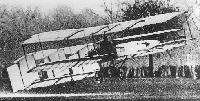 |
L.Opdyke - French Aeroplanes Before the Great War /Schiffer/
|
| The Voisin-built Delagrange No I in flight, 30 March 1907.
|
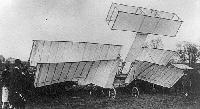 |
L.Opdyke - French Aeroplanes Before the Great War /Schiffer/
|
| The Delagrange No 1 crashed at Vincennes.
|
 |
Журнал - Flight за 1909 г.
|
| The Voisin-Delagrange biplane in full flight.
|
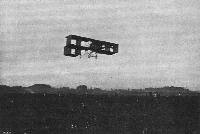 |
Журнал - Flight за 1909 г.
|
| MARKING A NEW EPOCH IN THE PROGRESS OF FLIGHT. - M. Delagrange flying on his Voisin machine round the Juvisy Aerodrome last Sunday upon the occasion o! its inauguration. This is the first public aerodrome in the world.
|
 |
Журнал - Flight за 1909 г.
|
| PARIS AERO SALON. - Rear view of the Delagrange Aeroplane, built by Voisin. This illustration shows the box-kite tail and the rudder, which is not visible in the photograph of the Farman machine.
|
 |
Журнал - Flight за 1909 г.
|
| PARIS AERO SALON. - General view of the principal part of the Aviation Section. In the foreground, a little to the left, is a back view of Ader's "Avion," to the right is the R.E.P. monoplane, and opposite to it is the Delagrange biplane. In mid-air is the "Ville de Bordeaux," and in the distance, down the Grande Nef, can be seen part of a spherical balloon.
|
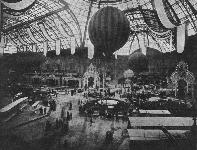 |
Журнал - Flight за 1909 г.
|
| PARIS FLIGHT SALON. - General view of the centre of the Grand Palais, showing the "Stands of Honour." In the middle, immediately under the spherical gas-bag, is the famous Bleriot cross-Channel machine. To its right is the "Rep" monoplane, in the extreme right foreground is the Farman biplane, to the left a French-made Wright flyer, and continuing round to the left the machines are respectively an Antoinette, a Voisin, and another Bleriot. The decorated spherical balloon in the distance is the Montgolfier.
|
 |
L.Opdyke - French Aeroplanes Before the Great War /Schiffer/
|
| The Delagrange No 1 on floats.
|
 |
P.Jarrett - Pioneer Aircraft: Early Aviation Before 1914 /Putnam/
|
| First flown in September 1907, the Voisin-Farman I began life with a wide-span tail unit, but had been substantially modified by its owner-pilot by the end of 1908, by which time it had made significant flights.
|
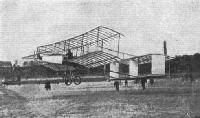 |
Журнал - Flight за 1909 г.
|
| Fig. 24. - Farman Aeroplane.
|
 |
L.Opdyke - French Aeroplanes Before the Great War /Schiffer/
|
| The slightly modified Henry Farman No 1. Note the tank on the top wing.
|
 |
L.Opdyke - French Aeroplanes Before the Great War /Schiffer/
|
| The Farman No Ibis in full flight.
|
 |
A.Andrews - The Flying Maschine: Its Evolution through the Ages /Putnam/
|
| A prize of 50,000 francs went to Henry Farman for the execution, on 13 January 1908, of the first kilometre return-to-base flight in Europe, achieved in his Voisin-Farman I (mod) biplane. Since Farman was not to adopt lateral control for another 9 months he could make no sharp turn and, once past the starting pylon, he had to fly in a banked attitude following a steady circle throughout.
|
 |
A.Andrews - The Flying Maschine: Its Evolution through the Ages /Putnam/
|
| Having modified his previous modification to produce the Voisin-Farman I-bis (mod) with four side-curtains between the wings, and putting up a creditable 40km flight with this adaptation, Henry Farman ‘saw the light’ regarding lateral control, which was making the flying of Wilbur Wright the envy of all French airmen, and he installed four broad wing-tip ailerons in his revised model, the Voisin-Farman I-bis (2nd mod). Later he used neater ailerons in his first ‘signed’ aircraft, the classic Henry Farman III.
|
 |
Журнал - Flight за 1909 г.
|
| PARIS AERO SALON. - View of the Voisin Aeroplane, built on the lines of "Farman No. 1." The machine carries a dummy pilot, and is mounted as if about to fly off into the Grand Nef.
|
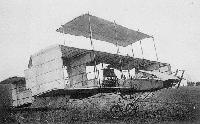 |
L.Opdyke - French Aeroplanes Before the Great War /Schiffer/
|
| Henry Farman's modified No Ibis - here - briefly - a triplane. Note, among many things, the cut-outs in the inner wing-curtains, and the ailerons on all 4 wings.
|
 |
Jane's All The World Aircraft 1913 /Jane's/
|
| H. FARMAN (1907). This famous machine is the first Voisin, and the one on which H. Farman taught himself to fly. It was the first machine to make a turn in the air. Won the Deutsh-Archdeacon Grand Prix, 13th January, 1908, with a flight of 1 minute, 28 seconds. The extra third plane was added later. An Austrian Syndicate subsequently bought the machine.
|
 |
L.Opdyke - French Aeroplanes Before the Great War /Schiffer/
|
| The Delagrange No 3, a modified version of No 2, itself a copy of the Henry Farman No I.
|
 |
Журнал - Flight за 1909 г.
|
| AERO SHOW AT OLYMPIA. - General view of "Delagrange No. V," which is exhibited by Mass Cars. This flyer is of Voisin construction, but has no side-curtains between the main planes, which are themselves less far apart than on the latest Voisin machines.
|
 |
Журнал - Flight за 1909 г.
|
| Mr. J. T. C. Moore-Brabazon on his Voisin biplane, which has been fitted with an 8-cyl. 50-h.p. E.N.V. water-cooled motor.
|
 |
Журнал - Flight за 1909 г.
|
| Mr. J. T. C. Moore-Brabazon's "Bird of Passage" outside Short Brothers' factory at Shellbeach. The elevator in this view is shown tilted.
|
 |
Журнал - Flight за 1909 г.
|
| AERO SHOW AT OLYMPIA. - Mr. Moore-Brabazon's "Bird of Passage," the actual Voisin flyer with which he has been making successful experiments in France. The engine now fitted on this machine is an 8-cylinder E.N.V.
|
 |
Журнал - Flight за 1909 г.
|
| Side view of the Voisin biplane, showing the relative position of the engine and the construction of the outrigger which carries the tail.
|
 |
Журнал - Flight за 1909 г.
|
| View of the Voisin biplane from behind, showing the relative size of the rudder and tail.
|
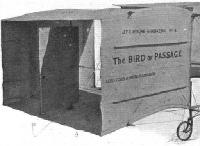 |
Журнал - Flight за 1909 г.
|
| Detailed view of the tail on the Voisin biplane, showing method of mounting the rudder, and also the small wheels which support it on the ground.
|
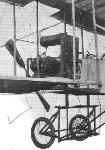 |
Журнал - Flight за 1909 г.
|
| General view of the central part of the Voisin biplane, showing its suspension on the chassis.
|
 |
Журнал - Flight за 1909 г.
|
| Detailed view of the elevator on the Voisin biplane, showing how it is mounted and stayed.
|
 |
Журнал - Flight за 1909 г.
|
| Two views of the engine on the Voisin biplane; also showing the pilot's seat and the control. In the right-hand view the seat itself, B, has been turned up into a vertical position. The timing and throttle-levers, A, and also the switch, A1are to be seen in the centre of the above illustration.
|
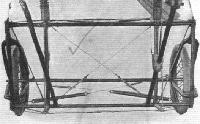 |
Журнал - Flight за 1909 г.
|
| Detailed view of the chassis on the Voisin biplane, showing how the wheel axle is anchored to the chassis frame by springs.
|
 |
Журнал - Flight за 1909 г.
|
| AERO SHOW AT OLYMPIA. - The Voisin machine, exhibited by Mr. F. R. Simms, seen from in front. This illustration gives an excellent view of the elevator, and of its interconnection with the controlling lever. The engine and propeller are not fitted.
|
 |
P.Jarrett - Pioneer Aircraft: Early Aviation Before 1914 /Putnam/
|
| The nacelle of the Musee de l'Air's Voisin biplane reproduction, showing the pusher engine and the pilot's simple push-pull control to the forward elevator.
|
 |
Журнал - Flight за 1909 г.
|
| The remarkable custom which pertains in France of invoking the blessing of the Church upon motor cars, aerodromes, flyers, and such like goods and chattels, was referred to in FLIGHT last week. A couple of interesting photographs are given above of the ceremony of blessing the new Aerodrome at Juvisy by the Archbishop of Parts, and incidentally of a couple of aeroplanes, respectively named "Ile de France" and "Alsace," - which were brought forward to receive a share of the Episcopal favour.
|
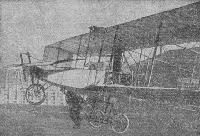 |
В.Шавров - История конструкций самолетов в СССР до 1938 г.
|
| Авиатор Леганье "везет" свой "Вуазен" 1909 г. к месту старта
|
 |
Журнал - Flight за 1909 г.
|
| Voisin biplane upon which M. Paulhan effected his flights last week, showing at close quarters the elevators and the extra wheel which has been fitted to the nose of the machine. The motor employed by M. Paulhan is a 50-h.p. Gnome.
|
 |
Журнал - Flight за 1910 г.
|
| Madame Paulhan, in her aviation costume, about to mount on to her husband's Voisin biplane, with which he was flying at Issy last year. This is a very good sample of one of the many "faked" aviation photographs so prevalent in France.
|
 |
Jane's All The World Aircraft 1913 /Jane's/
|
| VOISIN (1908). The first European aeroplanes to fly with any real success.
|
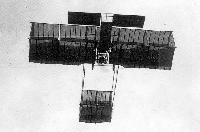 |
L.Opdyke - French Aeroplanes Before the Great War /Schiffer/
|
| Paulhan's Standard Voisin.
|
 |
Журнал - Flight за 1910 г.
|
| "WOLSELEY No. I." - The above photograph of M. de Baeder flying at Chalons on the Voisin aeroplane, "Wolseley No. 1," fitted with a 50-60 h.p. Wolseley flight motor, is the subject of a charming postcard which is being issued by the Woiseley Co. The occasion of the picture was when de Baeder won his four prizes in one day for flying on this machine.
|
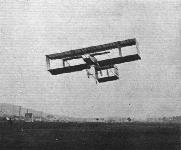 |
Журнал - Flight за 1909 г.
|
| On Sunday last "De Rue" made some successful flights at Belfort on his Voisin biplane. It will be remembered that some time ago we mentioned the fact that "De Rue" was really the assumed name for the moment of a prominent leader in aeronautics. That leader, we are now at liberty to mention, is the well-known Capt. Ferber. He is at the wheel of his machine in our photograph.
|
 |
A.Andrews - The Flying Maschine: Its Evolution through the Ages /Putnam/
|
| The Standard Voisin pusher biplane seen here, a box-kite construction with front elevators and side-curtains to aid its already formidable stability, was the unexciting all-purpose ‘Ford Model T’ of the air for some years. But it was overdue back at the drawing board because of its then retrogressive design. It was very easy to fly so long as the pilot wanted only to go in a straight line.
|
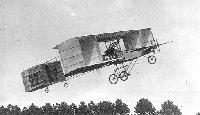 |
L.Opdyke - French Aeroplanes Before the Great War /Schiffer/
|
| The Standard Voisin of Bunau-Varilla.
|
 |
L.Opdyke - French Aeroplanes Before the Great War /Schiffer/
|
| Henry Fournier's No 1 Standard Voisin; the engine has not yet been installed. Note the chalk lines on the rudder to guide the painter.
|
 |
Журнал - Flight за 1910 г.
|
| De Baeder, who secured several prizes at Mourmelon last week in a single day, on his Voisin machine, which is fitted with a 50-60-h.p. British-built Wolseley engine.
|
 |
Журнал - Flight за 1910 г.
|
| De Baeder, one of the latest successful flyers at Mourmelon, and his Wolseley-engined Voisin biplane.
|
 |
Журнал - Flight за 1910 г.
|
| A neat method of fixing a two-bladed propeller to the crankshaft is to use the shanks of the blades as bolts, and to fasten them by nuts to the boss, as is shown in the above illustration of the Voisin flyer.
|
 |
L.Opdyke - French Aeroplanes Before the Great War /Schiffer/
|
| Assembling the Kapferer Voisin on the field.
|
 |
L.Opdyke - French Aeroplanes Before the Great War /Schiffer/
|
| The nacelle of the Kapferer Voisin. Note the sandbags to prevent it tipping backward on the trestles.
|
 |
L.Opdyke - French Aeroplanes Before the Great War /Schiffer/
|
| The biplane built for Hans Reissner.
|
 |
Журнал - Flight за 1909 г.
|
| VOISIN AIRCRAFT AT RHEIMS READY FOR THE STARTER. - The machines are: No. 5. Jean Gobron biplane (Gobron motor); No. 33. Henry Fournier's machine (Itala motor); No. 27. M. E. Bunau-Varilla's machine (E.N.V. motor); and the tail seen on the left is M. Sanchez Bensa's Voisin (Antoinette motor).
|
 |
Журнал - Flight за 1909 г.
|
| AT BRESCIA AVIATION MEETING. - A popular flyer - M. Anzani starting on his Voisin biplane. Note the trail of exhaust from the motor.
|
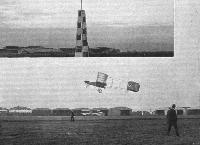 |
Журнал - Flight за 1909 г.
|
| FLIGHT IN ENGLAND. - M. Rougier is seen on his Voisin machine, passing the aviators' sheds at Blackpool during the long-distance competition.
|
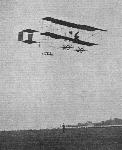 |
Журнал - Flight за 1909 г.
|
| FLIGHT PHOTOGRAPHS. - Another example of a genuine enlarged photograph, with two machines in the air at a distance. This was "snapped" at Blackpool during the big meeting, and shows Paulhan on his Henry Farman machine, and Rougier behind on a Voisin biplane.
|
 |
Журнал - Flight за 1910 г.
|
| HELIOPOLIS AVIATION MEETING. - An incident during the competitions. Latham, on his Antoinette, with Rougier, on his biplane, behind.
|
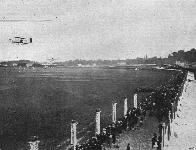 |
Журнал - Flight за 1909 г.
|
| JUVISY AVIATION WEEK. - M. Paulhan, on his Voisin biplane, and Count de Lambert (nearest), on his Wright flyer, during the contests at Port Aviation, near Paris, at the end of last week. General view of the aerodrome taken from the top of the Grand Stand.
|
 |
Журнал - Flight за 1909 г.
|
| RHEIMS AVIATION MEETING. - A race in the air between M. Bunau Varilla on a Voisin biplane and, in the distance, M. Tissandier on one of his Wright flyers.
|
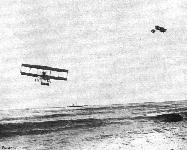 |
Журнал - Flight за 1910 г.
|
| NICE FLIGHT MEETING. - Mr. A. Rawlinson, on the left, on his Henry Farman, and M. Rougier on his Voisin biplane, flying over the sea at Nice.
|
 |
Журнал - Flight за 1910 г.
|
| SEEN FROM ABOVE. - Striking photograph taken from an airship during the Rheims Aviation Meeting last year. On the left is a biplane in full flight, whilst the shadow of the dirigible itself from which the picture was snapped is seen on the right. Note also the pylone and the white guide marks on the ground, which were used for indicating the "course" for the flying men.
|
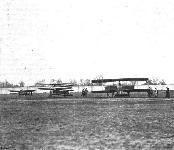 |
Журнал - Flight за 1910 г.
|
| FLYING MACHINES AT BROOKLANDS ON EASTER MONDAY. - A trio of aeroplanes. From left to right: Mr. Astley's Lane monoplane, Mr. A. V. Roe's triplane, and Mr. Moreing's Voisin biplane.
|
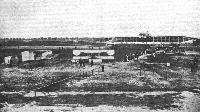 |
Журнал - Flight за 1910 г.
|
| General view of the Stands and Starting Place on the Johannisthal Aerodrome near Berlin. - The machines in the foreground are Baron de Caters' Voisin (No. 1) and Herr Jeannin's Henry Farman.
|
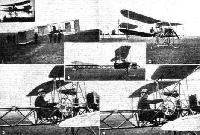 |
Журнал - Flight за 1910 г.
|
| Some interesting views of the Swiss-built Dufaux biplane which has been constructed by the Dufaux Brothers of Geneva. In No. 3 M. Henry Dufaux is in the pilot's seat, in No. 4 M. Armand Dufaux is in charge, and in Fig. 6 the machine is in flight. No. 1 is a Voisin machine, with M. Nigg at the wheel. The photographs, which are from the Suisse Sportive, were taken at the Viry Aerodrome, near Geneva.
|
 |
P.Jarrett - Pioneer Aircraft: Early Aviation Before 1914 /Putnam/
|
| The Voisin factory at Issy-les-Moulineaux in 1908. In the foreground is the curious and unsuccessful 'Flying Fish' short-span tandem triplane bought by Lieutenant Fritsche.
|
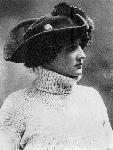 |
L.Opdyke - French Aeroplanes Before the Great War /Schiffer/
|
| The author could not easily find a photograph of the Standard Voisin owned and flown by the Baronne Raymonda de la Roche, so he settled for this fine photograph of the lady herself. The baroness set many records and was world-famous, finally dying in one of her own aircraft.
|
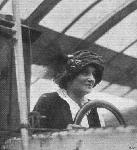 |
Журнал - Flight за 1909 г.
|
| Baroness de la Roche, the First "Aviatress" of the World. - Last week the Baroness flew on a Voisin biplane for 300 metres, and afterwards twice round the Chalons Camp-a distance of about four miles.
|
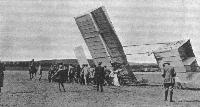 |
Журнал - Flight за 1909 г.
|
| WHAT A WRECKED BIPLANE LOOKS LIKE. - Henri Fournie's Voisin machine after his first accident.
|
 |
P.Jarrett - Pioneer Aircraft: Early Aviation Before 1914 /Putnam/
|
| The big and cumbersome early Voisin biplanes, with their side curtains between the wings and no lateral control, were vulnerable to wind. This one came to grief at Brooklands, Surrey, in January 1910 as a result of 'trying to turn in a side wind without laeving the ground'.
|
 |
В.Шавров - История конструкций самолетов в СССР до 1938 г.
|
1909 Voisin "Bird of Passage" pusher biplane
Country of Origin: France Designed and built by Brothers Voisin
|
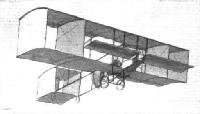 |
Журнал - Flight за 1913 г.
|
| The Voisin biplane with which Henry Farman won the Deutsch-Archdeacon prize of 50,000 francs on January 13th, 1908, by being the first to fly, under official observation, a circular course of 1 kilom. in length.
|
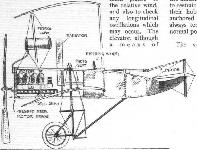 |
Журнал - Flight за 1909 г.
|
| In the Voisin biplane the engine, the pilot's seat, and the elevator are earned in a girder frame of semi-elliptic form, which is attached direct to a tw0-wheeled chassis, and forms a unit with the machine. In the above drawing the relative position of the main decks, which are attached to the girder, is also indicated.
|
 |
Журнал - Flight за 1909 г.
|
| Voisin (Delagrange, Farman)
|
 |
Журнал - Flight за 1909 г.
|
| The Voisin type of biplane is characterised by the use of a tail which is carried at the extremity of an outrigger framework extending some distance to the rear of the machine.
|
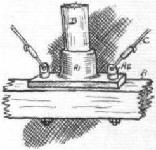 |
Журнал - Flight за 1909 г.
|
| Rigid socket-joint on the Voisin flyer.
|
 |
Журнал - Flight за 1909 г.
|
| Diagram showing the camber of the decks on the Voisin biplane.
|
 |
Журнал - Flight за 1909 г.
|
| Sketch of the two-bladed propeller on Mr. J. T. C. Moore - Brabazon's "Bird of Passage." The inset drawing shows how the blade is riveted to its arm.
|
 |
Журнал - Flight за 1909 г.
|
| Sketch of the steering wheel control on the Voisin biplane, showing the connection between the spindle and the elevator.
|
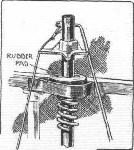 |
Журнал - Flight за 1909 г.
|
| The entire weight of the main decks, engine and pilot oa the Voisin biplane, carried on a pair of helical springs abutting against manganese steel brackets, arranged as shown in the above sketch.
|
 |
Журнал - Flight за 1909 г.
|
| Diagram of the bracing of the main spars constituting the leading edges of the decks on the Voisin biplane. The square member in the centre is the girder which carries the engine and the pilot's seat.
|
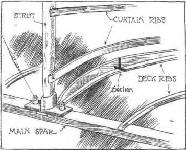 |
Журнал - Flight за 1909 г.
|
| Sketch showing the skeleton framework forming the deck of the Voisin biplane.
|
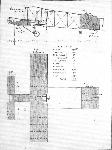 |
Журнал - Flight за 1909 г.
|
| MR. J. T. C. MOORE-BRABAZON'S "BIRD OF PASSAGE." - The Voisin biplane, 1908-9 type.
|
















































































